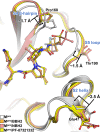Covalent narlaprevir- and boceprevir-derived hybrid inhibitors of SARS-CoV-2 main protease
- PMID: 35477935
- PMCID: PMC9046211
- DOI: 10.1038/s41467-022-29915-z
Covalent narlaprevir- and boceprevir-derived hybrid inhibitors of SARS-CoV-2 main protease
Abstract
Emerging SARS-CoV-2 variants continue to threaten the effectiveness of COVID-19 vaccines, and small-molecule antivirals can provide an important therapeutic treatment option. The viral main protease (Mpro) is critical for virus replication and thus is considered an attractive drug target. We performed the design and characterization of three covalent hybrid inhibitors BBH-1, BBH-2 and NBH-2 created by splicing components of hepatitis C protease inhibitors boceprevir and narlaprevir, and known SARS-CoV-1 protease inhibitors. A joint X-ray/neutron structure of the Mpro/BBH-1 complex demonstrates that a Cys145 thiolate reaction with the inhibitor's keto-warhead creates a negatively charged oxyanion. Protonation states of the ionizable residues in the Mpro active site adapt to the inhibitor, which appears to be an intrinsic property of Mpro. Structural comparisons of the hybrid inhibitors with PF-07321332 reveal unconventional F···O interactions of PF-07321332 with Mpro which may explain its more favorable enthalpy of binding. BBH-1, BBH-2 and NBH-2 exhibit comparable antiviral properties in vitro relative to PF-07321332, making them good candidates for further design of improved antivirals.
© 2022. This is a U.S. government work and not under copyright protection in the U.S.; foreign copyright protection may apply.
Conflict of interest statement
The authors declare no competing interests.
Figures





Update of
-
Covalent narlaprevir- and boceprevir-derived hybrid inhibitors of SARS-CoV-2 main protease: room-temperature X-ray and neutron crystallography, binding thermodynamics, and antiviral activity.Res Sq [Preprint]. 2022 Feb 11:rs.3.rs-1318037. doi: 10.21203/rs.3.rs-1318037/v1. Res Sq. 2022. Update in: Nat Commun. 2022 Apr 27;13(1):2268. doi: 10.1038/s41467-022-29915-z. PMID: 35169792 Free PMC article. Updated. Preprint.
References
-
- Meo SA, Bukhari IA, Akram J, Meo AS, Klonoff DC. COVID-19 vaccines: comparison of biological, pharmacological characteristics and adverse effects of Pfizer/BioNTech and Moderna vaccines. Eur. Rev. Med. Pharmacol. Sci. 2021;25:1663–1679. - PubMed
Publication types
MeSH terms
Substances
Supplementary concepts
LinkOut - more resources
Full Text Sources
Other Literature Sources
Miscellaneous

